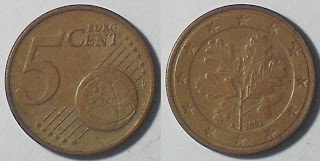Germany 1 cent, 2004

Weight: 2.27gm
Metal: copper plated steel
Diameter: 16.3mm
Edge: plain
Reverse: globe and denomination
Obverse: Oak branch
Germany 2 cent, 2008
Metal: copper plated steel
Diameter: 16.7mm
Edge: grooved
Obverse: globe and denomination
Reverse: Oak branch
5 cent, 2007
Metal: copper plated steel
Diameter: 21.2mm
Edge: plain
The significance of the oak leaves: The oak tree is the national tree, a symbol of Germany. Thick woodland is the sort of image that Germany has had for many centuries, with about one-third of the country still being forested. German history is full of lores related to the woods, starting with the German tribal chieftain Hermann, also known as Arminius to the Romans, defeated the invading German legions in the murky forests of Teutoburg. Just as we have a stereotype of a sandy place for the word "Arabia", similarly the Romans had a stereotype of a marshy forest for the word "Germany" for a very long time in history. Even in modern times, there are the romantics and the fairy tales of the Grimm brothers in the 19th century. The tree even finds its way into idioms and epithets like the proud German saying "firm as a German oak".
But of late, the great German oaks have been threatened by the menace of pollution. The danger to oaks is greater as compared to most other trees as oaks have a long lifespan of about 1000 years; so they tend to accumulate more poison due to pollution over the long years of their lifespan. The number of trees having damaged crowns(upper section including branches and leaves) has gone upto a record 51% due to pollution as well as parasites and other environmental conditions.
10 cent, 2003
Metal: brass
Edge: grooved
Diameter: 19.7mm
Reverse: map of Europe and denomination
Obverse: Brandenburg gate
20 cent, 2008
Metal: brass
Diameter: 22.2mm
Edge: notched
Reverse: Brandenburg gate
50 cent, 2002
 The ten cent , twenty cent and the fifty cent coin has the Brandenburg gate on the obverse. The Brandenburg gate is the only remaining one of a series of gates through which one formally entered Berlin. To the North of the gate stands the Reichstag, the German parliament. The gate was commisioned by King Frederick William II of Prussia and was built in 1791.
The ten cent , twenty cent and the fifty cent coin has the Brandenburg gate on the obverse. The Brandenburg gate is the only remaining one of a series of gates through which one formally entered Berlin. To the North of the gate stands the Reichstag, the German parliament. The gate was commisioned by King Frederick William II of Prussia and was built in 1791.When the Nazis came to power they used the gate as a political symbol . The gate survived the second world war, and the governments of East Germany and West Germany revived the gate and traffic flowed through freely until the erection of the Berlin wall in 1961.







u dont have 1 euro, 50 cents.i have this coin....
ReplyDeletewhat a stupid comment Pushpak. Kulraj has many other coins which i bet you don't have. also, 50 cents and 1 euro are common circulating coins so no need to boast about it.
ReplyDeleteeasy friend.
ReplyDeleteI am now going to post euro sets of different countries one by one. In the same way i said "just shut up and watch" when he posted this under the $$US dollar$$ post.
The bottomline: "shut up and watch" :P
well i don't understand mentality of people like pushpak , its kiddish mentality of a 10 yr. old kid saying 'you don't have that coin, i have that' . kulraj why don't you delete such ignorant and unnecessary comments?
ReplyDeleteas for me thanks kul, i came to your site from fake east india coins, you saved me from buying some fake 'east india' hanuman, ram coins.
I dont need to delete such a comment. He is only making a joke of himself. Then again, don't 90% of us have this mentality, i mean people buy things just to show off and not because they need them. People buy a blackberry or a 40" LCD just because some other person has. Is that not kiddish?
ReplyDeleteGreat site. I gather more information for my coins. Thanks. geonumis.blogspot.com
ReplyDelete